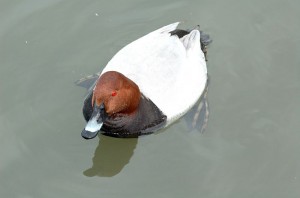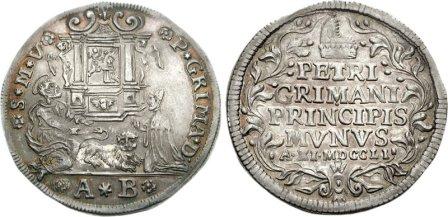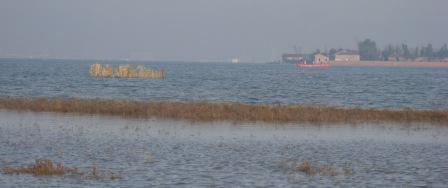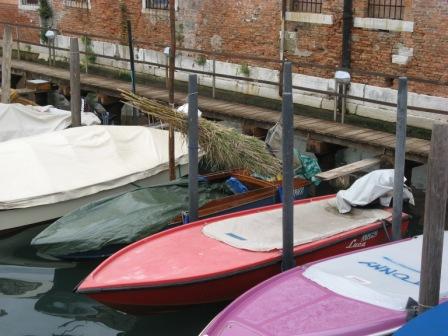Walking home yesterday afternoon, I noticed this boat. And I instantly deduced that hunting season is about to open in the Venetian lagoon. It isn’t just the camouflaging reeds that give the game away, it’s the fact that they are freshly cut.
Actually, a glance at the Veneto Region’s official calendar of hunting season shows that it had already begun (September 1, and a few scattered dates thereafter) for a small group of winged creatures that keep to the shore, such as turtledoves, blackbirds, jays, magpies, and crows.

The Veneto has the highest density of hunters in Italy. However, the total number of hunters in Italy has fallen from 1.4 million in 2000 to about 800,000 today. I can’t usefully interpret either one of those facts but there they are.
Bird hunting — I don’t mean pheasant and duck and other famous flying comestibles, but lesser-known sort-of comestibles such as song thrushes and skylarks — is a topic that could easily lead us into unpleasant political and environmentalist territory (the island of Ponza, for example, is essentially a seasonal killing field for any avian who enters its air space), so I’ll just stick to the basics.
In the Veneto, from September 19 till January 31, a person sitting in a blind freezing in the dark in the middle of the water is permitted to attempt to slay mallards, coots, common moorhens, common teals, shovelers, pochards, gadwalls, water rails, wigeons, Northern pintails, garganeys, tufted ducks, common snipes, Jack snipes, and lapwings.
Their landbound confreres gazing skyward will also be freezing and waiting for partridge, red-legged partridge, pheasant, ruff, skylark, woodcock, fieldfare, song thrush, redwing, common wood pigeon, and quail.

The catbird isn’t found in Europe, but all these hunters will be sitting in its proverbial seat starting tomorrow, because the Venetian lagoon is situated on one of the most important flyways in Europe. At certain times of year there can be as many as 200,000 birds here, nesting or resting or spending the winter diving, dabbling, or digging through the mudflats at low tide.
When UNESCO designated Venice as a World Heritage Site in 1987, it specifically included the Venetian lagoon. You wouldn’t have guessed that by the antics that go on in it, but let’s move on for now. The lagoon covers an area of some 212 square miles, and is one of the few coastal wetlands left in Europe, a region which has lost 2/3 of its wetlands in the past 100 years.
In other words, the lagoon is one of the best places in Europe to be a bird, except in the winter. Depending on your species, a hunter is allowed to bag from 35 to 50 of your relatives in a season.
The days designated for this divertissement are Wednesday and Saturday in the Southern Lagoon, and Thursday and Sunday in the Northern and the Caorle Lagoon (where Hemingway used to love to hunt).
When you have shot one bird flying you have shot all birds flying,” Ernest Hemingway wrote. “They are all different and they fly in different ways but the sensation is the same and the last one is as good as the first.” You can’t say that about everything, or even most things, in this life, so I’ll let him have the last word on the subject.
I’m glad I mentioned hunting, though, because it constitutes a direct link to the Great Days of the Venetian Republic.

From farthest antiquity, the doge was expected to give a specific Christmas present to all the noble families, who formed the Great Council (there were 1,200 such families for a long period, then the number began to increase).
That present was five mallards per family, which comes to 6,000 ducks a year. Eventually this number dropped to two, but finally there were so few birds that on June 28, 1521, the Council decreed that instead of the ducks, the doge would give each patrician a coin specially minted for the occasion, worth one-quarter of a ducat. This coin was known as an osella, Venetian for “bird.”

With the exception of two extremely short-lived gentlemen, every doge from Antonio Grimani (1521) to Ludovico Manin (1797) minted an osella each year. One side bore a generic image of him kneeling before San Marco, and the obverse a particular design highlighting an important event or aspect of the past year.

The Banca Popolare di Vicenza (People’s Bank of Vicenza) happens to own the most complete collection of oselle in the world visible to the public, which comprises 275 coins. After the middle of the 17th century, the oselle were minted in gold. The Bank of Vicenza collection was on display here for a short while last spring, and even though I know next to nothing about numismatics, they were spectacular.
Just think: Even when they start with ducks they end up with money. I love this town.



